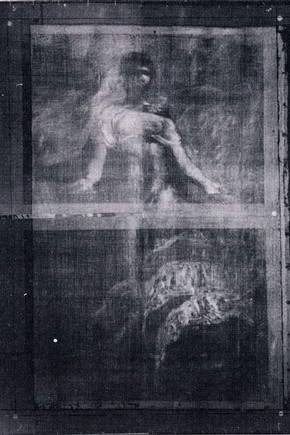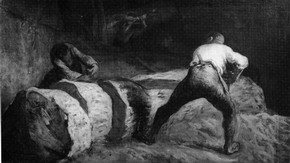Conservation Journal
April 1993 Issue 07
A successful double act: paintings conservation & PDP (prints, drawings and paintings) collection
When Sir George Hayter's large painting of 'The Angels Ministering to Christ' was being cleaned and extensively conserved, and the frame was being repaired, again extensively, it was intended that the work should be hung in Room 121 with other mid-Victorian artefacts. The results of conservation were so spectacular that it was decided to display the picture with explanatory texts and photographs (and including a recently acquired oil sketch for the painting) on the wall in the New Restaurant foyer for a few months. This proved a great success with the public - an intrinsically interesting and striking painting, highlighted on display in a prominent place.
This display was a successful collaboration between conservator and curator, and presented to the public information about a work of art that would otherwise be confined to Conservation Department and Paintings catalogue files. It also seemed to respond to a perceived demand by our Museum visitors for information concerning the physical history of a work of art.
Consequently the display became the first in a series of 'Recent Discoveries'. The third painting was hung for a six-month period in June, to be followed by two more in 1993. The second picture of the series was Millet's 'Woodsawyers' (Fig 1) A recent technical examination had revealed that Millet had used the canvas previously for his submission to the 1848 State Competition in France, an image of the personification of the Republic (Fig. 2.). Unsuccessful in the competition, he re-used the canvas, after a good deal of cutting down, adding on, and turning it through ninety degrees. However, his design was clearly visible in the X-radiograph, and the display of the picture again alongside photographs and other supporting material was a great success. An article written jointly with Bruce Laughton (Professor of Art History at Queen's University, Kingston, Canada) published the full results in the January 1992 issue of the Burlington Magazine.

Fig. 2. X- radiograph revealing the figure of La Republique beneath the 'Woodsawyer' (click image for larger version)
The third display was of Le Nain's 'Flageolet Player', a painting officially catalogued as by a 'follower of Le Nain'. Following recent conservation, discoveries have enabled a reattribution of the work to one of the Le Nain family. Close examination, using infra-red reflectography, revealed the presence of a windmill in the sky area at the top right, either painted out by the artist at some stage, or evidence of another unfmished composition underneath the 'Flageolet Player'. Next, X-radiography revealed a portrait, also underneath the top paint surface, at right angles to the finished picture. There are a few surviving portraits by the Le Nain brothers, and the style of our portrait is similar. Furthermore, scientific and technical analysis has shown a palette and technique comparable to those of autograph works.
Other recent discoveries include some pentimenti in Constable's famous 'Leaping Horse' sketch. This was not displayed in our series, as it was promised to the great 1991 Tate Gallery Constable exhibition, and although the pentimenti were revealed too late to include in the Tate exhibition catalogue, the information was again published by curator and conservator in the Burlington Magazine (May 1992).
The 'Recent Discoveries' displays simply consist of the painting and two standard panels with text and photographs, designed in-house. This method of display is very flexible. A future candidate for the series is extremely large, Gerard's portrait of Louis XVIII of France, which normally hangs in the Wellington Museum at Apsley House, (administered of course by the V&A). That display would focus on the 'before and after' aspect of conservation, as Gerard's portrait was disfigured - to all intents and purposes 'lost' - under grime and discoloured varnish. Our intention is that new definitions of works of art in the collection are not only made, but are made public, and, we hope, made popular.
April 1993 Issue 07
- Editorial
- Conservation liaison: a case study
- Alabaster conservation
- Mind the gap: conservation of a Delftware bowl
- Accessories for the UV-Vis-NIR spectrophotometer: the external integrating head
- Frank Lloyd Wright stained glass
- 'It was the least unethical thing we could do'
- A successful double act: paintings conservation & PDP (prints, drawings and paintings) collection
- The art of natural selection
